Input interpretation

KClO_3 potassium chlorate + HI hydrogen iodide ⟶ H_2O water + I_2 iodine + KCl potassium chloride
Balanced equation
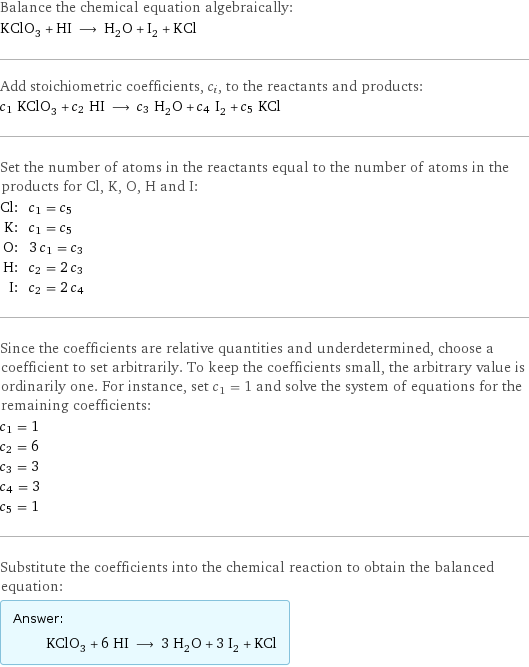
Balance the chemical equation algebraically: KClO_3 + HI ⟶ H_2O + I_2 + KCl Add stoichiometric coefficients, c_i, to the reactants and products: c_1 KClO_3 + c_2 HI ⟶ c_3 H_2O + c_4 I_2 + c_5 KCl Set the number of atoms in the reactants equal to the number of atoms in the products for Cl, K, O, H and I: Cl: | c_1 = c_5 K: | c_1 = c_5 O: | 3 c_1 = c_3 H: | c_2 = 2 c_3 I: | c_2 = 2 c_4 Since the coefficients are relative quantities and underdetermined, choose a coefficient to set arbitrarily. To keep the coefficients small, the arbitrary value is ordinarily one. For instance, set c_1 = 1 and solve the system of equations for the remaining coefficients: c_1 = 1 c_2 = 6 c_3 = 3 c_4 = 3 c_5 = 1 Substitute the coefficients into the chemical reaction to obtain the balanced equation: Answer: | | KClO_3 + 6 HI ⟶ 3 H_2O + 3 I_2 + KCl
Structures

+ ⟶ + +
Names

potassium chlorate + hydrogen iodide ⟶ water + iodine + potassium chloride
Reaction thermodynamics
Enthalpy
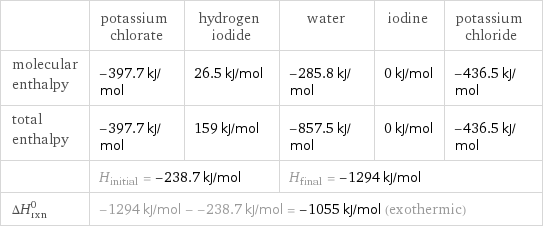
| potassium chlorate | hydrogen iodide | water | iodine | potassium chloride molecular enthalpy | -397.7 kJ/mol | 26.5 kJ/mol | -285.8 kJ/mol | 0 kJ/mol | -436.5 kJ/mol total enthalpy | -397.7 kJ/mol | 159 kJ/mol | -857.5 kJ/mol | 0 kJ/mol | -436.5 kJ/mol | H_initial = -238.7 kJ/mol | | H_final = -1294 kJ/mol | | ΔH_rxn^0 | -1294 kJ/mol - -238.7 kJ/mol = -1055 kJ/mol (exothermic) | | | |
Gibbs free energy
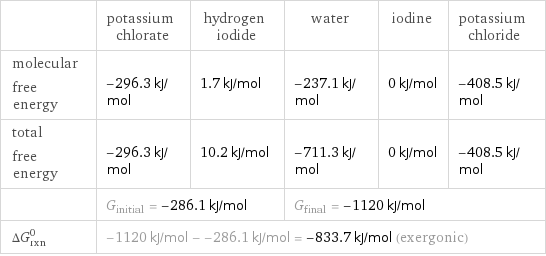
| potassium chlorate | hydrogen iodide | water | iodine | potassium chloride molecular free energy | -296.3 kJ/mol | 1.7 kJ/mol | -237.1 kJ/mol | 0 kJ/mol | -408.5 kJ/mol total free energy | -296.3 kJ/mol | 10.2 kJ/mol | -711.3 kJ/mol | 0 kJ/mol | -408.5 kJ/mol | G_initial = -286.1 kJ/mol | | G_final = -1120 kJ/mol | | ΔG_rxn^0 | -1120 kJ/mol - -286.1 kJ/mol = -833.7 kJ/mol (exergonic) | | | |
Equilibrium constant
![Construct the equilibrium constant, K, expression for: KClO_3 + HI ⟶ H_2O + I_2 + KCl Plan: • Balance the chemical equation. • Determine the stoichiometric numbers. • Assemble the activity expression for each chemical species. • Use the activity expressions to build the equilibrium constant expression. Write the balanced chemical equation: KClO_3 + 6 HI ⟶ 3 H_2O + 3 I_2 + KCl Assign stoichiometric numbers, ν_i, using the stoichiometric coefficients, c_i, from the balanced chemical equation in the following manner: ν_i = -c_i for reactants and ν_i = c_i for products: chemical species | c_i | ν_i KClO_3 | 1 | -1 HI | 6 | -6 H_2O | 3 | 3 I_2 | 3 | 3 KCl | 1 | 1 Assemble the activity expressions accounting for the state of matter and ν_i: chemical species | c_i | ν_i | activity expression KClO_3 | 1 | -1 | ([KClO3])^(-1) HI | 6 | -6 | ([HI])^(-6) H_2O | 3 | 3 | ([H2O])^3 I_2 | 3 | 3 | ([I2])^3 KCl | 1 | 1 | [KCl] The equilibrium constant symbol in the concentration basis is: K_c Mulitply the activity expressions to arrive at the K_c expression: Answer: | | K_c = ([KClO3])^(-1) ([HI])^(-6) ([H2O])^3 ([I2])^3 [KCl] = (([H2O])^3 ([I2])^3 [KCl])/([KClO3] ([HI])^6)](../image_source/58205b89648924bb39410fcb13c20266.png)
Construct the equilibrium constant, K, expression for: KClO_3 + HI ⟶ H_2O + I_2 + KCl Plan: • Balance the chemical equation. • Determine the stoichiometric numbers. • Assemble the activity expression for each chemical species. • Use the activity expressions to build the equilibrium constant expression. Write the balanced chemical equation: KClO_3 + 6 HI ⟶ 3 H_2O + 3 I_2 + KCl Assign stoichiometric numbers, ν_i, using the stoichiometric coefficients, c_i, from the balanced chemical equation in the following manner: ν_i = -c_i for reactants and ν_i = c_i for products: chemical species | c_i | ν_i KClO_3 | 1 | -1 HI | 6 | -6 H_2O | 3 | 3 I_2 | 3 | 3 KCl | 1 | 1 Assemble the activity expressions accounting for the state of matter and ν_i: chemical species | c_i | ν_i | activity expression KClO_3 | 1 | -1 | ([KClO3])^(-1) HI | 6 | -6 | ([HI])^(-6) H_2O | 3 | 3 | ([H2O])^3 I_2 | 3 | 3 | ([I2])^3 KCl | 1 | 1 | [KCl] The equilibrium constant symbol in the concentration basis is: K_c Mulitply the activity expressions to arrive at the K_c expression: Answer: | | K_c = ([KClO3])^(-1) ([HI])^(-6) ([H2O])^3 ([I2])^3 [KCl] = (([H2O])^3 ([I2])^3 [KCl])/([KClO3] ([HI])^6)
Rate of reaction
![Construct the rate of reaction expression for: KClO_3 + HI ⟶ H_2O + I_2 + KCl Plan: • Balance the chemical equation. • Determine the stoichiometric numbers. • Assemble the rate term for each chemical species. • Write the rate of reaction expression. Write the balanced chemical equation: KClO_3 + 6 HI ⟶ 3 H_2O + 3 I_2 + KCl Assign stoichiometric numbers, ν_i, using the stoichiometric coefficients, c_i, from the balanced chemical equation in the following manner: ν_i = -c_i for reactants and ν_i = c_i for products: chemical species | c_i | ν_i KClO_3 | 1 | -1 HI | 6 | -6 H_2O | 3 | 3 I_2 | 3 | 3 KCl | 1 | 1 The rate term for each chemical species, B_i, is 1/ν_i(Δ[B_i])/(Δt) where [B_i] is the amount concentration and t is time: chemical species | c_i | ν_i | rate term KClO_3 | 1 | -1 | -(Δ[KClO3])/(Δt) HI | 6 | -6 | -1/6 (Δ[HI])/(Δt) H_2O | 3 | 3 | 1/3 (Δ[H2O])/(Δt) I_2 | 3 | 3 | 1/3 (Δ[I2])/(Δt) KCl | 1 | 1 | (Δ[KCl])/(Δt) (for infinitesimal rate of change, replace Δ with d) Set the rate terms equal to each other to arrive at the rate expression: Answer: | | rate = -(Δ[KClO3])/(Δt) = -1/6 (Δ[HI])/(Δt) = 1/3 (Δ[H2O])/(Δt) = 1/3 (Δ[I2])/(Δt) = (Δ[KCl])/(Δt) (assuming constant volume and no accumulation of intermediates or side products)](../image_source/cce29195e9bccf29dc87556f7c3a9e83.png)
Construct the rate of reaction expression for: KClO_3 + HI ⟶ H_2O + I_2 + KCl Plan: • Balance the chemical equation. • Determine the stoichiometric numbers. • Assemble the rate term for each chemical species. • Write the rate of reaction expression. Write the balanced chemical equation: KClO_3 + 6 HI ⟶ 3 H_2O + 3 I_2 + KCl Assign stoichiometric numbers, ν_i, using the stoichiometric coefficients, c_i, from the balanced chemical equation in the following manner: ν_i = -c_i for reactants and ν_i = c_i for products: chemical species | c_i | ν_i KClO_3 | 1 | -1 HI | 6 | -6 H_2O | 3 | 3 I_2 | 3 | 3 KCl | 1 | 1 The rate term for each chemical species, B_i, is 1/ν_i(Δ[B_i])/(Δt) where [B_i] is the amount concentration and t is time: chemical species | c_i | ν_i | rate term KClO_3 | 1 | -1 | -(Δ[KClO3])/(Δt) HI | 6 | -6 | -1/6 (Δ[HI])/(Δt) H_2O | 3 | 3 | 1/3 (Δ[H2O])/(Δt) I_2 | 3 | 3 | 1/3 (Δ[I2])/(Δt) KCl | 1 | 1 | (Δ[KCl])/(Δt) (for infinitesimal rate of change, replace Δ with d) Set the rate terms equal to each other to arrive at the rate expression: Answer: | | rate = -(Δ[KClO3])/(Δt) = -1/6 (Δ[HI])/(Δt) = 1/3 (Δ[H2O])/(Δt) = 1/3 (Δ[I2])/(Δt) = (Δ[KCl])/(Δt) (assuming constant volume and no accumulation of intermediates or side products)
Chemical names and formulas
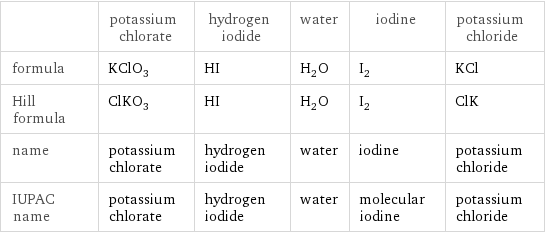
| potassium chlorate | hydrogen iodide | water | iodine | potassium chloride formula | KClO_3 | HI | H_2O | I_2 | KCl Hill formula | ClKO_3 | HI | H_2O | I_2 | ClK name | potassium chlorate | hydrogen iodide | water | iodine | potassium chloride IUPAC name | potassium chlorate | hydrogen iodide | water | molecular iodine | potassium chloride
Substance properties
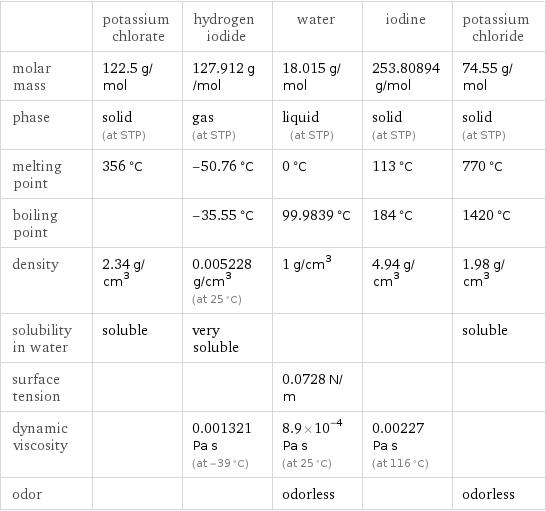
| potassium chlorate | hydrogen iodide | water | iodine | potassium chloride molar mass | 122.5 g/mol | 127.912 g/mol | 18.015 g/mol | 253.80894 g/mol | 74.55 g/mol phase | solid (at STP) | gas (at STP) | liquid (at STP) | solid (at STP) | solid (at STP) melting point | 356 °C | -50.76 °C | 0 °C | 113 °C | 770 °C boiling point | | -35.55 °C | 99.9839 °C | 184 °C | 1420 °C density | 2.34 g/cm^3 | 0.005228 g/cm^3 (at 25 °C) | 1 g/cm^3 | 4.94 g/cm^3 | 1.98 g/cm^3 solubility in water | soluble | very soluble | | | soluble surface tension | | | 0.0728 N/m | | dynamic viscosity | | 0.001321 Pa s (at -39 °C) | 8.9×10^-4 Pa s (at 25 °C) | 0.00227 Pa s (at 116 °C) | odor | | | odorless | | odorless
Units
